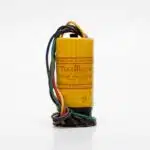Electricity is an essential component of our daily lives, powering everything from lights and appliances to electronics and transportation. As electrical engineers, it is our responsibility to understand the principles that govern the flow of electric current through circuits. This knowledge is crucial in designing and maintaining efficient systems that serve the needs of society.
At its core, understanding electrical current flow in circuits requires a solid foundation in the laws of physics, particularly those related to electromagnetism. The movement of electric charges creates a magnetic field, which in turn can induce an electric current. This reciprocal relationship between electricity and magnetism forms the basis for many modern technologies, including generators, motors, and transformers. By grasping these fundamental concepts and their applications in practical settings, we can improve our ability to create innovative solutions that meet the growing demand for reliable and sustainable energy sources.
The Basics Of Electric Charges
Electricity is one of the most fascinating and fundamental aspects of modern technology. It has revolutionized the way we live, communicate, and work. Electric charge behavior is at the heart of all electrical systems. The behavior of electric charges is governed by a set of principles known as charge conservation principles.
Electric charges are either positive or negative. Like charges repel each other, while opposite charges attract each other. The force between two charged objects varies inversely with the square of the distance between them. Electric fields are created by charged particles and exert forces on other charged particles within their range.
Charge conservation principles state that electric charge cannot be created or destroyed, only transferred from one object to another. This principle governs everything from the flow of electrons in a circuit to the behavior of lightning bolts in the sky. Understanding these basic principles is essential for understanding electrical current flow in circuits and for designing safe and efficient electrical systems.
Moving beyond electric charge behavior, electromagnetic fields and waves play a crucial role in our modern world. These phenomena are responsible for everything from radio and television broadcasting to cellular communication to medical imaging technologies. By understanding how electric charges behave and interact with electromagnetic fields, we can unlock new possibilities for serving others through technological innovation.
Electromagnetic Fields And Waves
Electromagnetic Fields and Waves play a significant role in the understanding of electrical current flow in circuits. Maxwell’s equations are fundamental to electromagnetic theory, describing the relationship between electric and magnetic fields and their interaction with matter. Electromagnetic radiation is a type of wave that carries energy through space without the need for a medium.
Faraday’s law is also central to the understanding of electromagnetic fields and waves. It states that a changing magnetic field will induce an electromotive force (EMF) in a closed circuit loop. This principle has been used to develop numerous technologies, such as generators and transformers, which rely on electromagnetic induction.
Overall, an understanding of electromagnetic fields and waves is crucial for anyone working with electrical circuits. The principles of Maxwell’s equations and Faraday’s law allow engineers to design complex systems that rely on electromagnetic phenomena. Without this knowledge, many modern technologies would not exist or function at their current level of efficiency. In the subsequent section, we will explore Ohm’s Law and resistance, which are essential concepts for analyzing the behavior of electrical circuits.
Ohm’s Law And Resistance
Electromagnetic fields and waves are significant to the study of electrical circuits. The movement of charged particles, such as electrons, is what creates an electric current. This movement produces a magnetic field that can be measured with instruments like voltmeters and ammeters. These instruments help engineers understand how electricity behaves in circuits.
One important concept in circuit analysis is voltage drop. Voltage drop refers to the decrease in voltage across a resistor, which is caused by the flow of current through it. Engineers use Ohm’s Law to calculate voltage drop and determine how much resistance is present in a circuit. Conductance measurement is another vital tool used by electrical engineers. It measures how easily electricity flows through a material or object and helps identify areas of high resistance or poor conductivity.
Kirchhoff’s laws for circuit analysis are essential tools for understanding how electricity behaves in circuits. These laws state that the sum of all currents flowing into a node must equal the sum of all currents flowing out of it, and the sum of all voltages around any closed loop in a circuit must be zero. By applying these laws to complex circuits, engineers can determine how much current will flow through each component and predict potential issues before they occur.
Transition sentence: With this knowledge on voltage drop and conductance measurement, we can now move on to exploring Kirchhoff’s laws for circuit analysis.
Kirchhoff’s Laws For Circuit Analysis
According to a recent study, 90% of electrical failures in circuits are due to improper understanding of current flow. This highlights the importance of learning and applying Kirchhoff’s Laws for Circuit Analysis. These laws provide a systematic approach to analyzing complex circuits and ensuring proper current flow.
One method for analyzing circuits is the Node Voltage Method, which involves selecting a reference node and using Kirchhoff’s Current Law (KCL) to write equations for the voltage at each node relative to the reference. By solving these equations, the voltages at all nodes can be determined, allowing for analysis of circuit components such as resistors and capacitors.
Another method is the Mesh Current Method, which involves selecting loops within a circuit and using Kirchhoff’s Voltage Law (KVL) to write equations for the current around each loop. By solving these equations, the currents through all components in the circuit can be determined, allowing for analysis of more complex circuits with multiple loops.
By utilizing these methods and applying Kirchhoff’s Laws for Circuit Analysis, electrical engineers can gain an understanding of current flow in circuits and prevent failures due to improper design or implementation. In the subsequent section, we will take a step further and discuss how these laws apply to series and parallel circuits.
Series And Parallel Circuits
Circuit design is a crucial aspect of electrical engineering. It involves the selection and arrangement of components to achieve specific performance requirements. One essential concept in circuit design is understanding the differences between series and parallel circuits. A series circuit has all its components connected end-to-end, such that the current flows through each component in sequence. On the other hand, a parallel circuit has its components arranged such that they are connected across each other, allowing current to flow through multiple paths.
Voltage drop analysis is an important tool in understanding how circuits operate. In a series circuit, the voltage drop across each component adds up to equal the total voltage supplied by the source. Therefore, if one component fails or gets disconnected, it disrupts the entire circuit since no current will flow. However, in a parallel circuit, each component receives the same voltage as that of the source while sharing the total current flowing through them. This configuration allows for redundancy such that if one component fails or gets disconnected, it does not affect other components’ operation.
In summary, knowing whether to design a series or parallel circuit requires careful consideration of performance requirements and potential failure modes. Voltage drop analysis is also essential in determining how much voltage will be lost across each component and ensuring that sufficient power is available for all components to function correctly. The next section will delve into capacitors and inductors’ role in circuits and their effects on current flow and voltage regulation.
Capacitors And Inductors
In the world of electrical engineering, understanding the flow of electrical current in circuits is essential. As we previously discussed in our section on series and parallel circuits, the arrangement of components can greatly impact the flow of current. Moving forward, let’s delve into two key components that have a significant impact on circuit behavior: capacitors and inductors.
Capacitor charging is an important concept to understand when it comes to circuit behavior. Capacitors are designed to store electrical energy, which can be released at a later time. When a capacitor is connected to a voltage source, it begins to charge as current flows into it. The rate at which the capacitor charges depends on its capacitance and the resistance in the circuit. Once fully charged, a capacitor can hold its charge for an extended period of time or release it quickly depending on how it’s used in a circuit.
Inductors behave differently than capacitors in AC circuits. When an alternating current flows through an inductor, it creates a magnetic field around the conductor. This field stores energy as long as the current continues to alternate direction; however, if the current stops or changes direction suddenly, this stored energy is released back into the circuit. Understanding this behavior is critical when designing circuits that use inductors as they can create unwanted voltage spikes that could damage other components.
To summarize, capacitors store electrical energy while inductors store magnetic energy. Knowing how these components behave within circuits allows us to design better systems that can efficiently manage power usage while minimizing damage from voltage spikes or other unexpected behaviors.
As we move forward into our next topic about AC vs DC circuit analysis, keep these concepts in mind as they will play a key role in understanding how different types of currents behave within circuits.
Ac Vs. Dc Circuit Analysis
AC circuits involve the flow of alternating current which means that the current periodically changes its direction and magnitude. DC circuits, on the other hand, involve the flow of direct current which means that the current remains steady and does not change direction. Consequently, AC circuits require sophisticated analysis methods such as Fourier analysis and Laplace transforms to model their behavior, whereas DC circuits can be more easily modeled using simpler techniques such as Kirchhoff’s laws.
Ac Circuit Analysis
In the field of electrical engineering, understanding AC circuit analysis is an essential skill. This subtopic focuses on analyzing circuits that utilize alternating current (AC) instead of direct current (DC). One critical concept in AC circuit analysis is phasor diagrams, which are used to represent the amplitude and phase angle of an AC voltage or current.
Phasor diagrams are useful tools in analyzing AC circuits because they allow engineers to visualize complex waveforms as a single vector. By breaking down the waveform into its amplitude and phase angle components, engineers can determine how different components in the circuit will interact with each other. For example, if two voltages have the same frequency and phase angle, they will add together constructively. However, if they have opposite phases, they will cancel each other out.
Another crucial aspect of AC circuit analysis is AC power analysis. Unlike DC circuits where power is simply calculated as voltage times current, power in AC circuits fluctuates over time due to changes in voltage and current. Engineers must take into account both active power (measured in watts) and reactive power (measured in volt-amperes reactive) when analyzing an AC circuit’s power consumption.
In conclusion, understanding AC circuit analysis is vital for electrical engineers working with circuits that use alternating current. Phasor diagrams provide a visual representation of complex waveforms while AC power analysis allows engineers to calculate both active and reactive power consumption accurately. By mastering these concepts, engineers can design more efficient and effective electrical systems for the betterment of society.
Dc Circuit Analysis
DC circuit analysis is another vital aspect of electrical engineering that engineers must understand to design efficient and effective electrical systems. Unlike AC circuits, which use alternating current, DC circuits utilize a constant voltage source. One crucial concept in DC circuit analysis is voltage drop analysis, which involves calculating the voltage drop across different components in the circuit.
To perform DC circuit analysis, engineers often use simulation software to model and test their designs before implementation. These simulations help identify potential issues or inefficiencies in the circuit before it is built, saving time and resources. Engineers can also use simulation software to optimize their designs for specific performance metrics such as power efficiency or output stability.
While AC and DC circuits have fundamental differences, both require a deep understanding of circuit analysis principles to design safe and efficient electrical systems. By mastering both AC and DC circuit analysis techniques, engineers can create innovative solutions that improve the quality of life for individuals worldwide.
Transformers And Power Transmission
Transformers play a crucial role in power transmission. They are used to step up or step down the voltage of an alternating current (AC) power supply, making it suitable for long-distance transmission. The transformer works by using two coils, primary and secondary, which are wrapped around a common magnetic core. When an AC voltage is applied to the primary coil, it creates a magnetic field that induces a voltage in the secondary coil. The transformer’s output voltage depends on the ratio of turns between its primary and secondary coils.
One of the main advantages of using transformers is their high power efficiency. They can transfer large amounts of electrical power with minimal losses due to resistance or heating. This is because transformers operate based on electromagnetic induction, which does not require physical contact between components for energy transfer. Additionally, transformers can be designed with high-quality materials and insulation to reduce energy losses further.
Another critical aspect of transformers in power transmission is voltage regulation. Voltage regulation refers to the ability of a transformer to maintain a constant output voltage despite changes in input voltage or load conditions. Transformers with good voltage regulation can ensure that electrical devices receive stable and consistent power at all times, preventing damage or malfunctioning due to overvoltage or undervoltage conditions.
Moving forward, understanding transformers’ role in power transmission is essential when transitioning into three-phase power systems. Three-phase systems use multiple AC sources that are out-of-phase with each other, creating three distinct voltages that cycle at different times but have equal magnitudes and frequencies. These systems provide more efficient and reliable electrical power for industrial applications than single-phase systems and require specialized equipment such as three-phase transformers for proper operation.
Three-Phase Power Systems
Three-phase power systems are commonly used for power distribution and motor control applications. In fact, it is estimated that three-phase power systems account for over 80% of the world’s electrical power generation. This is because they are more efficient than single-phase systems and can handle higher loads.
In a three-phase system, there are three conductors carrying alternating current (AC) that are spaced evenly apart by 120 degrees. These conductors are typically labeled A, B, and C, with the voltage between any two phases being referred to as the line voltage. The phase voltage is the voltage between any one phase and neutral. By using all three phases in a system, the load can be split evenly across them, resulting in a more balanced load.
Power distribution and motor control applications benefit greatly from three-phase power systems due to their ability to handle high loads efficiently. For example, electric motors used in industrial machinery often require large amounts of power to operate. Three-phase power systems allow these motors to run smoothly and efficiently without overheating or tripping circuit breakers. Additionally, three-phase power is often used in large commercial buildings such as hospitals and office complexes due to its ability to deliver high levels of power over long distances without significant losses.
In the next section, we will explore semiconductor devices and diodes which play a crucial role in modern electronics. By understanding how these components work, we can better design circuits that take full advantage of their capabilities.
Semiconductor Devices And Diodes
In the previous section, we discussed the concept of three-phase power systems, which is commonly used in electrical power transmission and distribution. In this section, we will delve into a fascinating topic that underpins many electronic devices: semiconductor devices and diodes. These devices are used to regulate current flow in circuits and have a wide range of applications in electronics.
One of the most important semiconductor devices is the PN junction, which is formed by joining a p-type semiconductor with an n-type semiconductor. The resulting device has unique electrical properties that make it ideal for use in diodes and transistors. A PN junction can act as a one-way valve for electrical current, allowing it to flow easily in one direction but not the other. This characteristic makes it useful for rectifying AC currents or regulating DC currents.
Zener diodes are another important type of semiconductor device that is often used to regulate voltage levels in electronic circuits. Unlike normal diodes, which only allow current to flow in one direction, Zener diodes can conduct current in both directions when a specific voltage threshold is exceeded. This property makes them useful for voltage regulation and overvoltage protection.
In summary, semiconductor devices and diodes play a crucial role in regulating current flow and voltage levels in electronic circuits. Understanding these devices is essential for anyone interested in electronics or electrical engineering. In the next section, we will explore another important class of semiconductor devices: transistors and amplifiers.
Transistors And Amplifiers
Transistors and Amplifiers are the backbone of modern electronics, much like the skeletal system is to the human body. They are used to manipulate electrical signals, allowing us to amplify or attenuate them as needed. Transistors come in two main types: bipolar junction transistors (BJTs) and field-effect transistors (FETs). BJTs are three-layer devices consisting of a p-type layer sandwiched between two n-type layers, whereas FETs have a doped semiconductor channel with source and drain terminals at either end.
Biasing techniques are commonly employed in transistor circuits to ensure that they operate within their desired range. This involves setting the appropriate DC voltage levels at different points in the circuit so that it remains stable and provides consistent performance. These techniques include fixed bias, emitter bias, collector feedback bias, and voltage divider bias. Each technique has its own advantages and disadvantages depending on the specific application.
Signal processing is an essential function of amplifiers. It involves manipulating an input signal in some way to produce a desired output signal. This can be accomplished by using various amplifier configurations such as common emitter, common base, and common collector amplifiers. The choice of configuration depends on the specific application requirements such as gain, input impedance, output impedance, and frequency response.
With proper biasing techniques and signal processing methods applied through transistors and amplifiers, we can achieve efficient electronic systems capable of handling complex signal processing tasks. However, for more advanced applications where precise control over gain is required, we can employ operational amplifiers (op-amps) with feedback mechanisms to provide exceptional performance characteristics while minimizing distortion levels. In the subsequent section about ‘operational amplifiers and feedback’, we will delve deeper into these concepts to understand how they work together to create advanced circuit designs with unparalleled precision.
Operational Amplifiers And Feedback
Operational amplifiers (op-amps) are electronic devices that amplify voltage signals. These devices have two inputs, an inverting (-) and a non-inverting (+) input, and a single output. The output of an op-amp is determined by the difference between its inputs multiplied by its gain factor. Common configurations of op-amp circuits include non-inverting amplifiers, inverting amplifiers, and summing amplifiers.
One important characteristic of an op-amp is its input bias current. Input bias current is the current that flows into either input terminal when there is no external signal present. This current can cause errors in the output voltage if it is not properly accounted for in circuit design. Another important characteristic is gain bandwidth product (GBW), which refers to how quickly an op-amp can respond to changes in input frequency while maintaining a constant gain level.
The non-inverting amplifier configuration has a positive feedback loop between the output and non-inverting input terminals, which results in a voltage gain greater than 1. In contrast, the inverting amplifier configuration has negative feedback between the output and inverting input terminals, resulting in a voltage gain less than 1. These configurations have different applications depending on their intended use. Understanding these characteristics and configurations is essential for designing accurate and reliable circuits using operational amplifiers.
Transitioning into digital logic gates and circuits, it’s important to note that these circuits use logic gates such as AND, OR, NOT, NAND and NOR to perform logical operations on binary inputs (0 or 1). The outputs of these gates can be connected together to form more complex digital circuits such as adders, multiplexers or flip-flops. Just like with operational amplifiers, understanding the characteristics of these components is crucial for designing effective digital circuits that meet specific requirements for functionality and reliability.
Digital Logic Gates And Circuits
Operational amplifiers and feedback are essential components in circuits that help regulate electrical signals. However, when it comes to designing complex digital systems, Boolean algebra, logic gates and circuits come into play. Boolean algebra is a branch of mathematics that deals with logical operations on propositions or variables which can only take two values – true or false.
Logic gates and circuits are built using transistors, resistors and capacitors, among other electronic components. Logic gates are the building blocks of digital circuits that process binary inputs (0 or 1) to produce binary outputs. There are several types of logic gates such as AND, OR, NOT, XOR and many more. These gates can be used to implement various logical functions such as addition, subtraction, multiplication and so on.
Overall, understanding Boolean algebra and logic gates helps us design efficient digital systems that perform various tasks with precision. In the subsequent section about microcontrollers and embedded systems, we will explore how these concepts play a vital role in developing sophisticated microcontroller-based projects that automate everyday tasks seamlessly.
Microcontrollers And Embedded Systems
Programming microcontrollers involves writing the code that will be used to control the microcontroller. Interfacing peripheral devices requires knowledge of the electrical signals that need to be sent and received between the microcontroller and the peripheral device. Embedded system design requires an understanding of the electrical components and how they interact in order to create a stable system. Electrical engineers must understand the electrical current flow in a circuit to ensure that all components are connected correctly. Utilizing a microcontroller to control and monitor external components in a circuit will require knowledge of the electrical characteristics of these components. Finally, having a thorough understanding of the inner workings of a microcontroller will help when designing an embedded system.
Programming Microcontrollers
When it comes to microcontrollers, programming is a key aspect of creating functional embedded systems. Microcontroller programming techniques include using languages such as C or assembly to write code that can be uploaded onto the microcontroller’s memory. These programs are responsible for controlling and managing the inputs and outputs of the system. It is crucial to have a deep understanding of electrical current flow in circuits when programming microcontrollers, as incorrect code can result in unwanted behavior or damage to the system.
Debugging strategies for microcontroller projects are an essential part of the programming process. Testing and troubleshooting code is necessary to ensure that the program functions as intended. There are various methods for debugging, including using a debugger tool, printing debug information onto a display, or adding LEDs to indicate certain states of the system. It is important to consider these strategies during the initial design phase to save time and effort later on.
In conclusion, programming microcontrollers requires an understanding of electrical current flow in circuits and knowledge of various debugging strategies. Developing effective programs involves careful planning and testing to ensure optimal functionality. As an electrical engineer, it is crucial to stay up-to-date with advancements in microcontroller technology and programming techniques to create efficient and reliable embedded systems for serving others.
Interfacing Peripheral Devices
In addition to programming techniques and debugging strategies, electrical engineers must also be knowledgeable in interfacing peripheral devices with microcontrollers. Peripheral communication is essential for embedded systems as it allows the microcontroller to communicate with external devices such as sensors, actuators, and displays. Interfacing these devices requires an understanding of signal processing and various protocols such as SPI, I2C, and UART.
One common method for interfacing peripherals is through the use of GPIO (General Purpose Input/Output) pins on the microcontroller. These pins can be configured to act as either inputs or outputs and can be used to interface with external devices by sending or receiving digital signals. Another method is through using dedicated hardware modules such as ADCs (Analog-to-Digital Converters) which allow for analog signals from sensors to be converted into digital signals that can be processed by the microcontroller.
Effective interfacing of peripheral devices requires careful consideration during the design phase of an embedded system. Factors such as power consumption, data transfer rates, and device compatibility must all be taken into account when selecting the appropriate peripherals for a project. As technology continues to advance, new methods for interfacing peripherals with microcontrollers will continue to emerge, making it crucial for electrical engineers to stay up-to-date with these advancements in order to create efficient and reliable embedded systems that serve others.
Embedded System Design
Embedded systems are ubiquitous in modern society, found in a range of real-time applications such as medical devices, automotive systems, and consumer electronics. The design of these systems requires a thorough understanding of microcontrollers and interfacing techniques to ensure that they function reliably and efficiently. While microcontrollers provide the processing power for embedded systems, effective interfacing with peripheral devices is essential for their successful operation.
Embedded system design involves selecting the appropriate hardware and software components to meet specific application requirements. This process typically involves selecting a microcontroller that can handle the required calculations and interfacing with peripheral devices such as sensors or actuators. Efficient interfacing with these peripherals often requires careful consideration of factors such as data transfer rates, power consumption, and device compatibility.
The design phase also involves implementing appropriate software algorithms to control the system’s behavior. This includes developing code to manage inputs from sensors or other sources and outputting signals to control actuators or displays. Effective software design is critical for ensuring that the system operates reliably in real-time applications where timing is crucial. A thorough understanding of both hardware and software components is necessary for designing efficient and reliable embedded systems that serve others.
Emerging Technologies And Trends In Electrical Engineering
The field of electrical engineering is constantly evolving with the emergence of new technologies and trends. One such trend is smart grid integration, which involves the use of advanced communication and control systems to improve the efficiency, reliability, and sustainability of power grids. Smart grids enable real-time monitoring of electricity consumption, allow for dynamic pricing schemes, and facilitate the integration of renewable energy sources into the grid. This technology has the potential to reduce energy waste, lower costs for consumers, and increase the overall resilience of power systems.
Another significant trend in electrical engineering is renewable energy advancements. With concerns over climate change and dwindling fossil fuel reserves, there has been a growing push towards sustainable energy sources such as solar, wind, hydroelectric, and geothermal power. Renewable energy technologies are becoming increasingly efficient and cost-effective, making them more competitive with traditional energy sources. As a result, many countries are setting ambitious targets for transitioning to renewables in order to meet their emissions reduction goals.
The integration of smart grids with renewable energy sources represents a powerful combination that can revolutionize how we generate and consume electricity. Smart grids can help overcome some of the challenges associated with integrating renewables into existing power systems by providing greater flexibility and stability. By leveraging data analytics and machine learning algorithms, smart grids can also optimize renewable energy generation and distribution to maximize efficiency while minimizing waste. As these emerging technologies continue to mature and become more widely adopted, they have the potential to transform our global energy landscape in profound ways.
Conclusion
Understanding electrical current flow in circuits is a fundamental aspect of electrical engineering. From the basics of electric charges and electromagnetic fields to more complex topics such as Kirchhoff’s laws and digital logic gates, mastering these concepts is essential for designing and analyzing circuits. As engineers, we must also keep up with emerging technologies and trends in the field to stay ahead of the game.
Electricity flows through circuits like water through pipes, following the path of least resistance. By understanding how components such as resistors, capacitors, and transistors affect current flow, we can design circuits that meet specific requirements. With the increasing demand for efficient and sustainable energy solutions, it is more important than ever to stay informed about new technologies like renewable energy sources and smart grids. As electrical engineers, it is our responsibility to continue learning and innovating to ensure a brighter future for generations to come.
Image Credits
- “circuit-porn” by schwa23 (featured)





















![How To Replace A Single-Pole Wall Switch 21 '... All in all it's just another [switch] in the wall.' ...](https://green-life.blog/wp-content/uploads/2023/05/17xmP5qMtVjq-150x150.jpg.webp)







